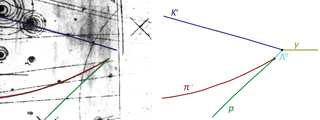Strangeness

The strangeness (Engl.) Denotes the quantum number of the strangeness of a particle or condition in the standard model of elementary particle physics . Along with isospin , charm , bottomness and topness, it is one of the flavor quantum numbers of quarks .
Its name comes from the first, in 1947 in the cosmic radiation discovered Strange particles (Engl. Strange particles ) whose life was significantly longer than the other then known unstable particles. These included kaons (mesons from a u or d quark and Strange quarks, they were the strange particles first discovered in 1947) and hyperons (baryons with a Strange quark). The strangeness quantum number was introduced by Murray Gell-Mann (1953), Abraham Pais and Kazuhiko Nishijima to explain the properties of these new particles .
Definition and choice of sign
| generation | 1 | 2 | 3 | |||
|---|---|---|---|---|---|---|
| Up type | up | charm | Top | |||
| Quark / antiquark | u | u | c | c | t | t |
| Flavor quantum number |
+ ½ | −½ | +1 | −1 | +1 | −1 |
| Isospin | Charm | Topness | ||||
| Down type | down | strange | bottom | |||
| Quark / antiquark | d | d | s | s | b | b |
| Flavor quantum number |
−½ | + ½ | −1 | +1 | −1 | +1 |
| Isospin | Strangeness | Bottomness | ||||
The strangeness of a system is equal to the negative number of Strange quarks s plus the number of associated antiparticles , the Strange antiquarks s :
For historical reasons, the convention is that a strange quark s, as a quark particle of the Down type , makes a contribution to the strangeness of the system (such as the hadron ) in which it is involved ; the Strange Antiquark s, however . (This sign convention applies - as well as the down-type - even for the bottom Ness of bottom quarks b with ; its antiparticle, the bottom-antiquark b has .) All other fundamental elementary particles are not "strange", ie have a strangeness of 0.
In contrast to this, the charm quark c and the top quark t as quarks of the Up type have the opposite signs for their associated quantum numbers : the charm and the topness ; the respective antiparticles c or t have or .
Physics of strange matter
Strange quarks are formed for example in the collision of protons and neutrons , protons and protons or protons and photons and have a relatively long life. This can be explained by the fact that the strong interaction is responsible for their creation , but the weak interaction is responsible for their decay . This leads to the fact that in the bubble chamber one can see so-called V-particles , V-shaped traces apparently emerging from nowhere. The decay vertex of this V-track mostly points to another (primary) vertex. The invisible connection line is created by a neutral particle with strangeness.
The strangeness remains in processes of strong and electromagnetic interaction , but can be changed with weak interaction.














